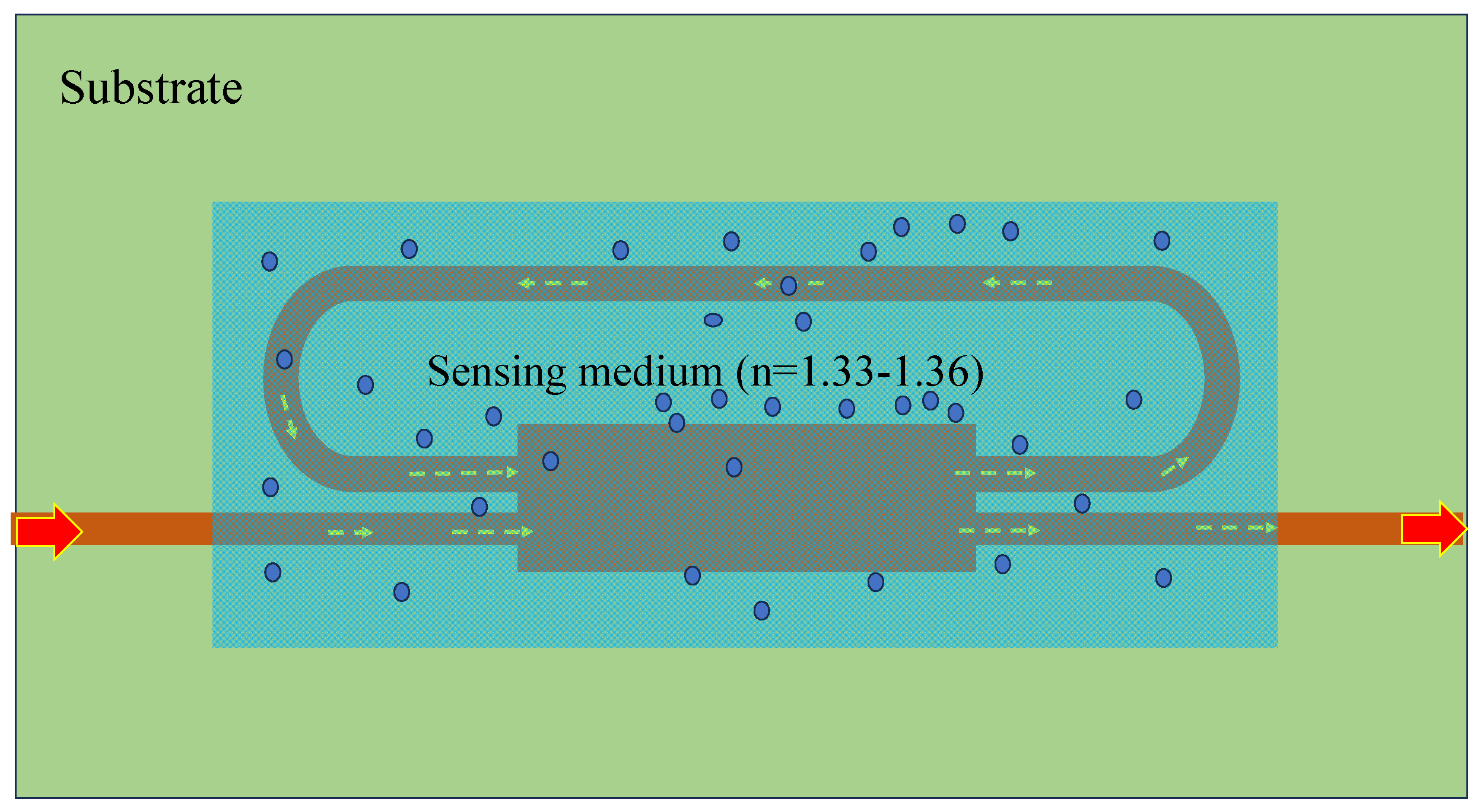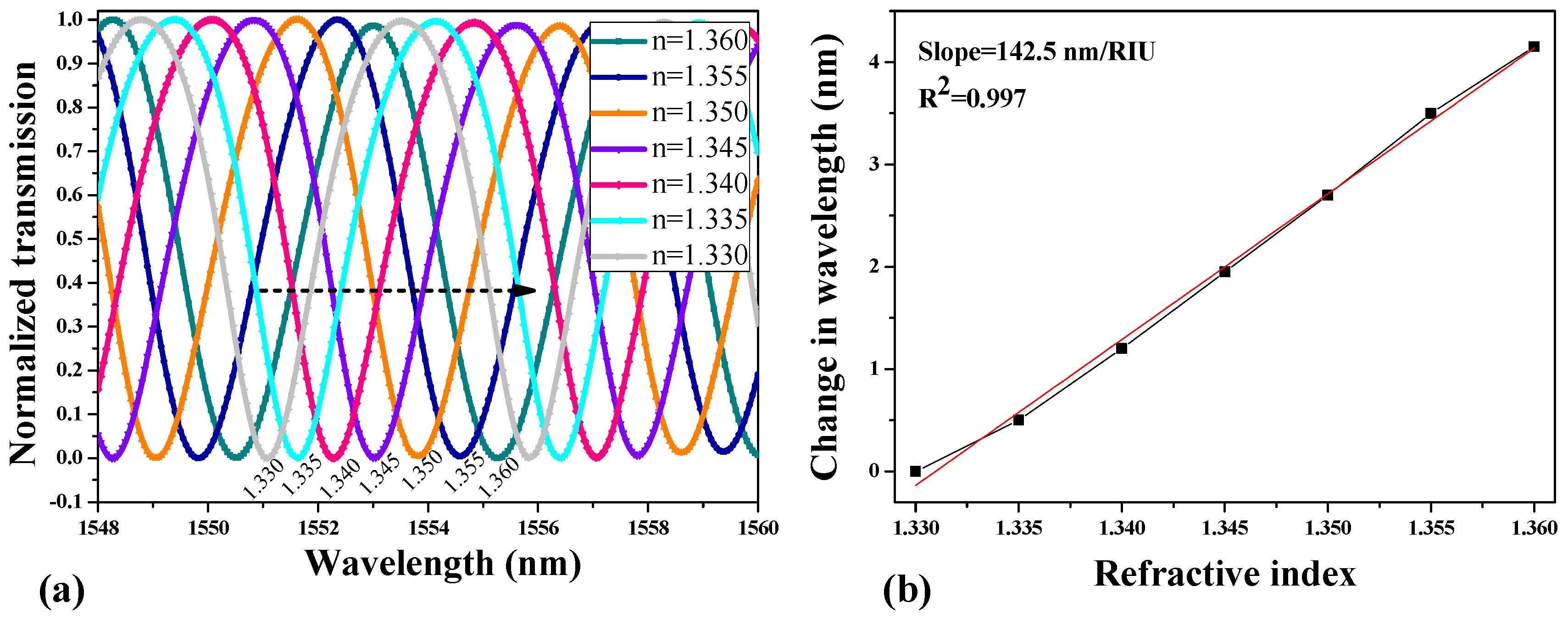Racetrack Ring Resonator Integrated with Multimode Interferometer Structure Based on Low-Cost Silica–Titania Platform for Refractive Index Sensing Application
Abstract
:1. Introduction
2. Device Design and Parametric Optimization
3. Refractive Index Sensing Operation
4. Concluding Statements
Author Contributions
Funding
Institutional Review Board Statement
Informed Consent Statement
Data Availability Statement
Acknowledgments
Conflicts of Interest
Abbreviations
References
- Talbot, H. LXXVI. Facts relating to optical science. No. IV. Lond. Edinb. Dublin Philos. Mag. J. Sci. 1836, 9, 401–407. [Google Scholar] [CrossRef]
- Bryngdahl, O. Image formation using self-imaging techniques. J. Opt. Soc. Am. 1973, 63, 416–419. [Google Scholar] [CrossRef]
- Ulrich, R. Light-propagation and imaging in planar optical waveguides. Nouv. Rev. d’Optique 1975, 6, 253–262. [Google Scholar] [CrossRef]
- Li, M.; Rao, L.; He, X.; Tian, F.; Pan, X.; Xin, X. Low-loss, broadband MMI coupler based on thin film lithium niobate platform. Phys. Scr. 2023, 98, 035506. [Google Scholar] [CrossRef]
- Tsao, S.-L.; Guo, H.-C.; Chen, Y.-J. Design of a 2 × 2 MMI MZI SOI electro-optic switch covering C band and L band. Microw. Opt. Technol. Lett. 2002, 33, 262–265. [Google Scholar] [CrossRef]
- Mu, S.; Liu, K.; Wang, S.; Zhang, C.; Guan, B.; Zou, D. Compact InGaAsP/InP 3 × 3 multimode-interference coupler-based electro-optic switch. Appl. Opt. 2016, 55, 1795–1802. [Google Scholar] [CrossRef] [PubMed]
- Al-Hetar, A.M.; Mohammad, A.B.; Supa’At, A.S.M.; Shamsan, Z.A.; Yulianti, I. Fabrication and characterization of polymer thermo-optic switch based on mmi coupler. Opt. Commun. 2011, 284, 1181–1185. [Google Scholar] [CrossRef]
- Chowdhury, A.Z. Performance study of silica-on-silicon based multimode interference (MMI) optical coupler. Photonic Sens. 2014, 4, 34–42. [Google Scholar] [CrossRef]
- Chiu, C.; Lay, T. Ring resonator with multimode waveguide turning-mirror couplers in InGaAsP-InP. Opt. Commun. 2011, 284, 3590–3592. [Google Scholar] [CrossRef]
- Yin, R.; Teng, J.; Chua, S. A 1×2 optical switch using one multimode interference region. Opt. Commun. 2008, 281, 4616–4618. [Google Scholar] [CrossRef]
- Song, J.; Ding, J. Polarisation-independent bidirectional triplexer using grating-assisted multimode interference coupler in silica-on-silicon platform. Electron. Lett. 2010, 46, 1213–1214. [Google Scholar] [CrossRef]
- Lai, Q.; Bachmann, M.; Melchior, H. Low-loss 1×N multimode interference couplers with homogeneous output power distributions realised in silica on Si material. Electron. Lett. 1997, 33, 1699–1700. [Google Scholar] [CrossRef]
- Kazanskiy, N.L.; Khonina, S.N.; Butt, M.A. A Review of Photonic Sensors Based on Ring Resonator Structures: Three Widely Used Platforms and Implications of Sensing Applications. Micromachines 2023, 14, 1080. [Google Scholar] [CrossRef] [PubMed]
- Ye, Z.; Wu, P.; Wang, H.; Jiang, S.; Huang, M.; Lei, D.; Wu, F. Multimode tunable terahertz absorber based on a quarter graphene disk structure. Results Phys. 2023, 48, 106420. [Google Scholar] [CrossRef]
- Chen, Z.; Cai, P.; Wen, Q.; Chen, H.; Tang, Y.; Yi, Z.; Wei, K.; Li, G.; Tang, B.; Yi, Y. Graphene Multi-Frequency Broadband and Ultra-Broadband Terahertz Absorber Based on Surface Plasmon Resonance. Electronics 2023, 12, 2655. [Google Scholar] [CrossRef]
- Lai, R.; Shi, P.; Yi, Z.; Li, H.; Yi, Y. Triple-Band Surface Plasmon Resonance Metamaterial Absorber Based on Open-Ended Prohibited Sign Type Monolayer Graphene. Micromachines 2023, 14, 953. [Google Scholar] [CrossRef] [PubMed]
- Jia, Z.; Huang, L.; Su, J.; Tang, B. Tunable Electromagnetically Induced Transparency-Like in Graphene metasurfaces and its Application as a Refractive Index Sensor. J. Light. Technol. 2021, 39, 1544–1549. [Google Scholar] [CrossRef]
- Quaranta, G.; Basset, G.; Martin, O.J.F.; Gallinet, B. Recent Advances in Resonant Waveguide Gratings. Laser Photonics. Rev. 2018, 12, 1800017. [Google Scholar] [CrossRef]
- Arora, P.; Talker, E.; Mazurski, N.; Levy, U. Dispersion engineering with plasmonic nano structures for enhanced surface plasmon resonance sensing. Sci. Rep. 2018, 8, 9060. [Google Scholar] [CrossRef]
- Xu, Y.; Bai, P.; Zhou, X.; Akimov, Y.; Png, C.E.; Ang, L.-K.; Knoll, W.; Wu, L. Optical Refractive Index Sensors with Plasmonic and Photonic Structures: Promising and Inconvenient Truth. Adv. Opt. Mater. 2019, 7, 1801433. [Google Scholar] [CrossRef]
- Homola, J. Surface Plasmon Resonance Sensors for Detection of Chemical and Biological Species. Chem. Rev. 2008, 108, 462–493. [Google Scholar] [CrossRef]
- Bellucci, S.; Fitio, V.; Yaremchuk, I.; Vernyhor, O.; Bendziak, A.; Bobitski, Y. Comparison of the Optical Planar Waveguide Sensors’ Characteristics Based on Guided-Mode Resonance. Symmetry 2020, 12, 1315. [Google Scholar] [CrossRef]
- Zhou, Y.; Wang, B.; Guo, Z.; Wu, X. Guided Mode Resonance Sensors with Optimized Figure of Merit. Nanomaterials 2019, 9, 837. [Google Scholar] [CrossRef] [PubMed]
- Kribich, K.; Copperwhite, R.; Barry, H.; Kolodziejczyk, B.; Sabattié, J.-M.; O’dwyer, K.; MacCraith, B. Novel chemical sensor/biosensor platform based on optical multimode interference (MMI) couplers. Sens. Actuators B Chem. 2005, 107, 188–192. [Google Scholar] [CrossRef]
- Peng, C.; Yang, C.; Zhao, H.; Liang, L.; Zheng, C.; Chen, C.; Qin, L.; Tang, H. Optical Waveguide Refractive Index Sensor for Biochemical Sensing. Appl. Sci. 2023, 13, 3829. [Google Scholar] [CrossRef]
- Le, T.-T. Two-channel highly sensitive sensors based on 4 × 4 multimode interference couplers. Photonic Sens. 2017, 7, 357–364. [Google Scholar] [CrossRef]
- Lv, H.; Liang, Y.; Wu, Z.; Han, X.; Morthier, G.; Zhao, M. Polymer-Based Microring Resonator with the Multimode Interference Coupler Operating at Very-Near-Infrared Wavelengths. Appl. Sci. 2019, 9, 2715. [Google Scholar] [CrossRef]
- Kim, D.-H.; Jeon, S.-J.; Lee, J.-S.; Hong, S.-H.; Choi, Y.-W. Novel S-Bend Resonator Based on a Multi-Mode Waveguide with Mode Discrimination for a Refractive Index Sensor. Sensors 2019, 19, 3600. [Google Scholar] [CrossRef]
- Ou, X.; Yang, Y.; Sun, F.; Zhang, P.; Tang, B.; Li, B.; Liu, R.; Liu, D.; Li, Z. Wide-range, ultra-compact, and high-sensitivity ring resonator biochemical sensor with CMOS-compatible hybrid plasmonic waveguide. Opt. Express 2021, 29, 19058–19067. [Google Scholar] [CrossRef] [PubMed]
- Ajad, A.K.; Islam, J.; Kaysir, R.; Atai, J. Highly sensitive bio sensor based on WGM ring resonator for hemoglobin detection in blood samples. Optik 2021, 226, 166009. [Google Scholar] [CrossRef]
- Butt, M.A.; Kaźmierczak, A.; Tyszkiewicz, C.; Karasiński, P.; Piramidowicz, R. Mode Sensitivity Exploration of Silica–Titania Waveguide for Refractive Index Sensing Applications. Sensors 2021, 21, 7452. [Google Scholar] [CrossRef]
- Butt, M.A.; Tyszkiewicz, C.; Karasiński, P.; Zięba, M.; Hlushchenko, D.; Baraniecki, T.; Kazmierczak, A.; Piramidowicz, R.; Guzik, M.; Bachmatiuk, A. Development of a low-cost silica-titania optical platform for integrated photonics applications. Opt. Express 2022, 30, 23678–23694. [Google Scholar] [CrossRef]
- Zięba, M.; Wojtasik, K.; Tyszkiewicz, C.; Gondek, E.; Nizioł, J.; Suchanek, K.; Wojtasik, M.; Pakieła, W.; Karasiński, P. High Refractive Index Silica-Titania Films Fabricated via the Sol–Gel Method and Dip-Coating Technique—Physical and Chemical Characterization. Materials 2021, 14, 7125. [Google Scholar] [CrossRef]
- Butt, M.A.; Kozlowski, L.; Piramidowicz, R. Numerical scrutiny of a silica-titania-based reverse rib waveguide with vertical and rounded sidewalls. Appl. Opt. 2023, 62, 1296–1302. [Google Scholar] [CrossRef]
- Butt, M.A.; Tyszkiewicz, C.; Wojtasik, K.; Karasiński, P.; Kaźmierczak, A.; Piramidowicz, R. Subwavelength Grating Waveguide Structures Proposed on the Low-Cost Silica–Titania Platform for Optical Filtering and Refractive Index Sensing Applications. Int. J. Mol. Sci. 2022, 23, 6614. [Google Scholar] [CrossRef]
- Butt, M.A. Thin-Film Coating Methods: A Successful Marriage of High-Quality and Cost-Effectiveness—A Brief Exploration. Coatings 2022, 12, 1115. [Google Scholar] [CrossRef]
- Wu, L.; Yang, D.; Fei, L.; Huang, Y.; Wu, F.; Sun, Y.; Shi, J.; Xiang, Y. Dip-Coating Process Engineering and Performance Optimization for Three-State Electrochromic Devices. Nanoscale Res. Lett. 2017, 12, 390. [Google Scholar] [CrossRef] [PubMed]
- Inui, C.; Tsuge, Y.; Kura, H.; Fujihara, S.; Shiratori, S.; Sato, T. Preparation of one-dimensional photonic crystals by sol–gel process for magneto-optical materials. Thin Solid Films 2008, 516, 2454–2459. [Google Scholar] [CrossRef]
- Butt, M.A.; Tyszkiewicz, C.; Karasiński, P.; Zięba, M.; Kaźmierczak, A.; Zdończyk, M.; Duda, Ł.; Guzik, M.; Olszewski, J.; Martynkien, T.; et al. Optical Thin Films Fabrication Techniques—Towards a Low-Cost Solution for the Integrated Photonic Platform: A Review of the Current Status. Materials 2022, 15, 4591. [Google Scholar] [CrossRef] [PubMed]
- Silicon Ring Resonators with a Free Spectral Range Robust to Fabrication Variations’. Available online: https://opg.optica.org/oe/fulltext.cfm?uri=oe-27-26-38698&id=424733 (accessed on 26 July 2023).
- Butt, M.A.; Shahbaz, M.; Kozłowski, Ł.; Kaźmierczak, A.; Piramidowicz, R. Silica-Titania Integrated Photonics Platform-Based 1 × 2 Demultiplexer Utilizing Two Serially Cascaded Racetrack Microrings for 1310 nm and 1550 nm Telecommunication Wavelengths. Photonics 2023, 10, 208. [Google Scholar] [CrossRef]
- Komljenovic, T.; Liang, L.; Chao, R.-L.; Hulme, J.; Srinivasan, S.; Davenport, M.; E. Bowers, J. Widely-Tunable Ring-Resonator Semiconductor Lasers. Appl. Sci. 2017, 7, 732. [Google Scholar] [CrossRef]
- Hajshahvaladi, L.; Kaatuzian, H.; Danaie, M. A very high-resolution refractive index sensor based on hybrid topology of photonic crystal cavity and plasmonic nested split-ring resonator. Photon. Nanostructures—Fundam. Appl. 2022, 51, 101042. [Google Scholar] [CrossRef]
- Singh, R.; Priye, V.; Chack, D. Highly Sensitive Refractive Index-Based Sensor for DNA Hybridization Using Subwavelength Grating Waveguide. IETE Tech. Rev. 2022, 39, 1463–1472. [Google Scholar] [CrossRef]
- Design of a Label-Free Photonic Crystal Refractive Index Sensor for Biomedical Applications—ScienceDirect’. Available online: https://www.sciencedirect.com/science/article/pii/S1569441017303735 (accessed on 1 August 2023).
- Robinson, J.T.; Chen, L.; Lipson, M. On-chip gas detection in silicon optical microcavities. Opt. Express 2008, 16, 4296–4301. [Google Scholar] [CrossRef]
- Huang, W.; Luo, Y.; Zhang, W.; Li, C.; Li, L.; Yang, Z.; Xu, P. High-sensitivity refractive index sensor based on Ge–Sb–Se chalcogenide microring resonator. Infrared Phys. Technol. 2021, 116, 103792. [Google Scholar] [CrossRef]
- Naznin, S.; Sher, S.M. Design of a lithium niobate-on-insulator-based optical microring resonator for biosensing applications. Opt. Eng. 2016, 55, 87108. [Google Scholar] [CrossRef]
- Xie, Y.; Zhang, M.; Dai, D. Design Rule of Mach-Zehnder Interferometer Sensors for Ultra-High Sensitivity. Sensors 2020, 20, 2640. [Google Scholar] [CrossRef]
- Wang, F.; Ma, S.; Ma, T.; Wang, X.; Yu, K.; Li, L. Refractive index sensing performances of a mid-infrared asymmetric mzi based on suspended gaas waveguides. Prog. Electromagn. Res. M 2022, 111, 173–183. [Google Scholar] [CrossRef]





| Variable | Value (µm) |
|---|---|
| W | 1.6 (fixed) |
| H | 0.41 (fixed) |
| WMMI | 8 (fixed) |
| L | 94 (fixed) |
| LMMI | 40 to 114 |
| R | 25 to 40 |
| g | 2 (fixed) |
| Structure | Platform | Sensitivity (nm/RIU) | FOM | LOD (RIU) | Reference |
|---|---|---|---|---|---|
| MRR-MMI | Si WG | 9000 for glucose; 6000 for ethanol | - | 2 × 10−4 for glucose; 1.3 × 10−5 for ethanol | [26] |
| MRR-MMI | Polymer | - | - | - | [27] |
| S-bend resonator-MMI | SU-8:SiO2 | 52 | - | - | [28] |
| MRR | Slotted Si | 490 | - | - | [46] |
| MRR | Ge-Sb-Se | 123 | - | 3.24 × 10−4 | [47] |
| MRR | LNOI | ~68 | - | 10−2 | [48] |
| MZI | SOI | 106 | - | 10−6 | [49] |
| MZI | GaAs | 854.5 | - | - | [50] |
| RTRR-MMI | SiO2:TiO2 | ~142.5 | 78.3 | - | This work |
Disclaimer/Publisher’s Note: The statements, opinions and data contained in all publications are solely those of the individual author(s) and contributor(s) and not of MDPI and/or the editor(s). MDPI and/or the editor(s) disclaim responsibility for any injury to people or property resulting from any ideas, methods, instructions or products referred to in the content. |
© 2023 by the authors. Licensee MDPI, Basel, Switzerland. This article is an open access article distributed under the terms and conditions of the Creative Commons Attribution (CC BY) license (https://creativecommons.org/licenses/by/4.0/).
Share and Cite
Butt, M.A.; Shahbaz, M.; Piramidowicz, R. Racetrack Ring Resonator Integrated with Multimode Interferometer Structure Based on Low-Cost Silica–Titania Platform for Refractive Index Sensing Application. Photonics 2023, 10, 978. https://doi.org/10.3390/photonics10090978
Butt MA, Shahbaz M, Piramidowicz R. Racetrack Ring Resonator Integrated with Multimode Interferometer Structure Based on Low-Cost Silica–Titania Platform for Refractive Index Sensing Application. Photonics. 2023; 10(9):978. https://doi.org/10.3390/photonics10090978
Chicago/Turabian StyleButt, Muhammad A., Muhammad Shahbaz, and Ryszard Piramidowicz. 2023. "Racetrack Ring Resonator Integrated with Multimode Interferometer Structure Based on Low-Cost Silica–Titania Platform for Refractive Index Sensing Application" Photonics 10, no. 9: 978. https://doi.org/10.3390/photonics10090978






